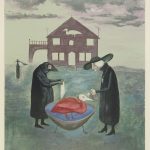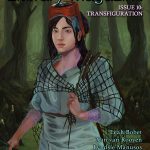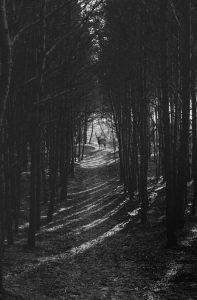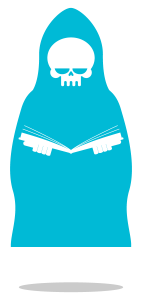In two months, our global lexicon changed. Words like physical distancing, social distancing, and self-isolation are at the tip of our tongue, waiting to be said every time we leave the house for work or shopping or when we call our family and tell them to be careful, stay safe.
Language evolves based on culture and knowledge, and I’m still learning the language of art and aesthetics. Japan’s ama divers (ama translates to ‘women of the sea’) inspired our April cover. Ama divers were free divers, meaning they trained their breathing techniques to withstand the freezing temperatures and water pressure. This was a traditionally female profession, with training passed down through family lines. We’ve always loved exploring feminine strength and power, especially when we’re able to look beyond the tip of a sword. We wanted to show a provider, someone hunting and foraging for her family. For our cover, our diver stands at the foreground of a swamp, surrounded by dense foliage. She holds netting and reeds, just having returned from diving into the waters. There’s an ethereal glow around her, highlighting the gills and scales on her neck and arms.
Tijana produced the finished version well before her deadline. The editors and I loved the result, but we wanted more, more strangeness, more fantasy, more something. Just like the worst client any freelancer ever had, we couldn’t express exactly what it was we wanted. Tijana was patient as I tried to find the right words to convey our thoughts for the cover, providing us with small alterations to the work, slowly layering more scales and glow.
 Language has formed much of Tijana’s life. She’s fluent in German, English and Serbian, and knowledgeable in French and Latin. How words are used and their influence has inspired Tijana to continue her education and inspired her to use that research in her artwork.
Language has formed much of Tijana’s life. She’s fluent in German, English and Serbian, and knowledgeable in French and Latin. How words are used and their influence has inspired Tijana to continue her education and inspired her to use that research in her artwork.
“Languages are a wonderful medium to get to know a culture by and that’s why I give them credit for introducing me to different history and people. I like learning idioms and phrases of different languages in general, so I enrolled and now I’m majoring in German and English.”
Art and storytelling are deeply entwined for Tijana. She aims to create fully realized characters in her work, finding ways to show the uniqueness of each character concept. On her Artstation page, you can see examples of her character design. In each piece, both original and fanart, there is a depth of individual detail. Clothing, posture, and setting are all carefully considered.
I believe that it is about the personality traits. The writers write the character, but concept artist need to ‘convey’ them. Show, don’t talk, is basically how we operate. If your character has a certain type of style of clothing to tell you who they are, it needs to be accommodated so. Most authors don’t write their characters that are ‘forgettable’ unless they were needed to. Same goes for characters that aren’t ‘needed’ to be dynamic to the storyline.
Recently, Tijana posted an update of an older piece to show her progress over the years and the new approach that she’s developed. For Envy, Tijana focused on incorporating more emotion and animation in the illustration.
…the first skill that I initially developed that helped me with art was through life alone and that was observation that came from natural curiosity. Why does a certain object seem that way, why is it there, if it’s an animated one, capable of moving, in what way can it twist itself? Can we twist it? These questions just popped up as I was looking on my hand typing away. It is essential for visual artists to understand when they are trying to convey the object in question on a canvas.
Tijana’s care for her language and her art is something we can all aspire toward. When you become focused on the negatives of our new language of isolation, remember to stay challenged and honest. Tijana’s leaves us all with fantastic advice:
Definitely don’t be afraid to challenge yourselves and never be afraid to seclude yourself to an idea that you want to develop or something you want to achieve. Pay attention to the times when you are doubting yourselves and stay always honest with what you want to accomplish. Art is something wonderful. Sometimes it is more challenging. More importantly – love that you do.
Artist Interview with Tijana Jankovic
Standard interview question: where are you from, how did you start drawing?
I’m from Serbia, currently attending Faculty of Philology and Arts in Kragujevac, which is also the city I live in. I’ve been drawing since childhood but have taken much more interested once I attended Grammar school. A big influence was a friend at that time who introduced me to games and concept art. I’m fairly new, with having started my career just a year ago. Since then, I’ve done multiple freelance jobs where I’ve done concept for various Dungeon and Dragon authors and designed covers for books, including one for your Apparition Lit Magazine.
What are some of your biggest artistic influences (both visual and non-visual artists, like writers and musicians)?
I don’t have a lot, but perhaps the most important one to mention would be Maynard James Keenan. His music is usually the one I go for when I am in need for inspiration. Others that have influenced me are Mikhail Bulgakov, Zdzisław Beksiński, Goethe, Joe Duplantier, Masashi Kishimoto and Alex Grey.
Are there any personal elements (like family history or personal stories) that you try to incorporate into your artwork?
I tend to incorporate them in my more expressive pieces. They are usually the end product of my untold feelings I have towards a person or situation, but I try to mitigate that. My childhood wasn’t pretty to say the least and art is my way of trying to get rid of those emotions in a healthy way.
What would be your dream project to work on?
I definitely lean towards games like Death Stranding, Hellblade, The Last of Us and Mass Effect, but it definitely would be amazing to work on one of the next installments of Bioware’s Dragon Age titles. The way the franchise has impacted me is something that I want to give back to. I’d say that to have a chance to work with an awesome team like them is something I could only describe with just this – It would be a dream come true.
You mention on ArtStation that you study languages and are fluent in German, English, and Serbian. Has your study of languages influenced your art?
Absolutely. I was born in Germany and lived there for 10 years. My family was a part of the huge wave of ‘Gastarbeiter’ from the 60s and had stayed there until we decided to come back to Serbia. When I attended Grammar school I also learned French and Latin. Languages are a wonderful medium to get to know a culture by and that’s why I give them credit for introducing me to different history and people. I like learning idioms and phrases of different languages in general, so I enrolled and now I’m majoring in German and English.
On your DeviantArt page, you write that you’d love to have a career in the gaming industry. What specific games or game characters have been especially inspiring to you as an artist?
Yes, that is correct. To name a few : Dragon Age Inquistion and Hellblade. I think that it’s not surprising that characters, who are developed so in depth tell a story the best. When designing a character, even without context, you should be able to see that they are unique. Whether you see a silhouette or just name a detail of a famous character design to someone, you know that you’ve done your job well. Their appearance has to tell a story that anyone can interpret for themselves. Creating games is creating stories that can intertwine in many possibilities and to me, art is storytelling.
Which of your works are you most proud of? Is there a piece you found especially challenging?
I would say that the ‘exploratory’ ones, such as my ‘The Seer’ piece are definitely the more challenging. I enjoy making even those because the process of ‘creating’ something new gives me the opportunity to experience more, as opposed to sticking to the same style that would be limited.
Your “Envy” portrait is a “revisited” version of an older piece. What changes do you see in yourself as an artist when you compare recent to older works? What skills have you intentionally honed, and are there aspects of your progression as an artist that grew and developed without your conscious effort?
More emotion. With experience I got to evolve the skill of portraying what I need that piece to tell. However, the first skill that I initially developed that helped me with art was through life alone and that was observation that came from natural curiosity. Why does a certain object seem that way, why is it there, if it’s an animated one, capable of moving, in what way can it twist itself? Can we twist it? These questions just popped up as I was looking on my hand typing away. It is essential for visual artists to understand when they are trying to convey the object in question on a canvas.
Finding out how things work was my motivation, and combined with the will to express myself led me to art itself. Each and every one of us has a unique understanding of this world and it is amazing (sometimes scary) when you see all the possibilities you can challenge yourself to.
Your “Insect Monster Illustration” is a concept design in which you play with color variations. What inspires you when it comes to concept designs? Do you often do multiple versions of a piece with variations in color, lighting, and style?
It is definitely important to know where you’re starting from. Simple mindless scribbling on a paper can often present itself as an idea to an experienced artist, which requires years of discipline and practice, but what if nothing comes to mind? It is definitely helpful to draw inspiration from something familiar, even if it is an everyday object that you’re surrounded with. That is usually the starting point for me.
The next ‘Phase’ would be the ‘Informatory’ Phase. I gather as much Information for the piece as I like and need. For visual artists this usually consists of reference images such as anatomy, setting, pose, materials, animals, etc. Using reference is ok and needed, how else are you going to draw something you’ve never seen before?
Next would be ‘The Exploratory Phase’, where I’d, as the name suggest, explore my idea. I don’t just stick to one pose, one angle or just jump right in without asking myself the ‘What if’ question. Some artist enjoy sticking to the initial idea, but to me it can be limiting to the other countless possibilities that can be produced. Experienced artists probably don’t struggle with this one that much. Another plus that I’d recommend with this would be that in this way you can develop and hone your skills much faster and that will always be a plus. Not to forget to mention, this stage can prove to be fun and challenging for any artist out there. However, depending on my time restrictions, (if I have any) this process can last quite a bit, but it is very well worth it.
What has always inspired me was an idea I would encounter through my everyday life. Art without life experience is nothing at all, and often seeing an appealing design or reading an exciting chapter in a book will do for me.
The “Insect Monster Illustration’’ came from a basic encounter I had that day with such one crawling along my floor. The Monster is just a way of being dramatic. No way I’d survive that thing in real life (which was the goal of that concept in the first place).
So in conclusion: Variation, mixing and trying out new things.
Similarly, how to do approach creating character concepts? Do you start with a theme, a setting, or does the character start fully formed?
When I read a fiction book where I meet characters as the chapter go by, I need to imagine actresses and actors or simple designs that ‘speak’ the character for me. It also helps when you have already directions given by writers (for instance, one character likes to wear a big shiny ring on their pinky finger). It helps to narrow the picture, if you will. Discerning a unique design is how you know you’ve done well as a concept artist, but how to get to that point?
I believe that it is about the personality traits. The writers write the character, but concept artist need to ‘convey’ them. Show, don’t talk, is basically how we operate. If your character has a certain type of style of clothing to tell you who they are, it needs to be accommodated so. Most authors don’t write their characters that are ‘forgettable’ unless they were needed to. Same goes for characters that aren’t ‘needed’ to be dynamic to the storyline.
This is usually what my direction is when I choose my concepts.
What drew you to digital art specifically? Do you also draw freehand, and if so, what is it about the two forms that attracts you as an artist?
I remember being mesmerized with images I saw on the internet as well as animation and film. However, my first way of learning was traditional and it wasn’t until I met a friend in High School who introduced me to concept art when I decided to save up and buy my tablet. Since working in the gaming industry is something I’m working on every day for, it’s been much more serious since then.
Last question! Do you have anything to promote to our readers?
Definitely don’t be afraid to challenge yourselves and never be afraid to seclude yourself to an idea that you want to develop or something you want to achieve. Pay attention to the times when you are doubting yourselves and stay always honest with what you want to accomplish. Art is something wonderful. Sometimes it is more challenging. More importantly – love that you do.
You can find more art by





